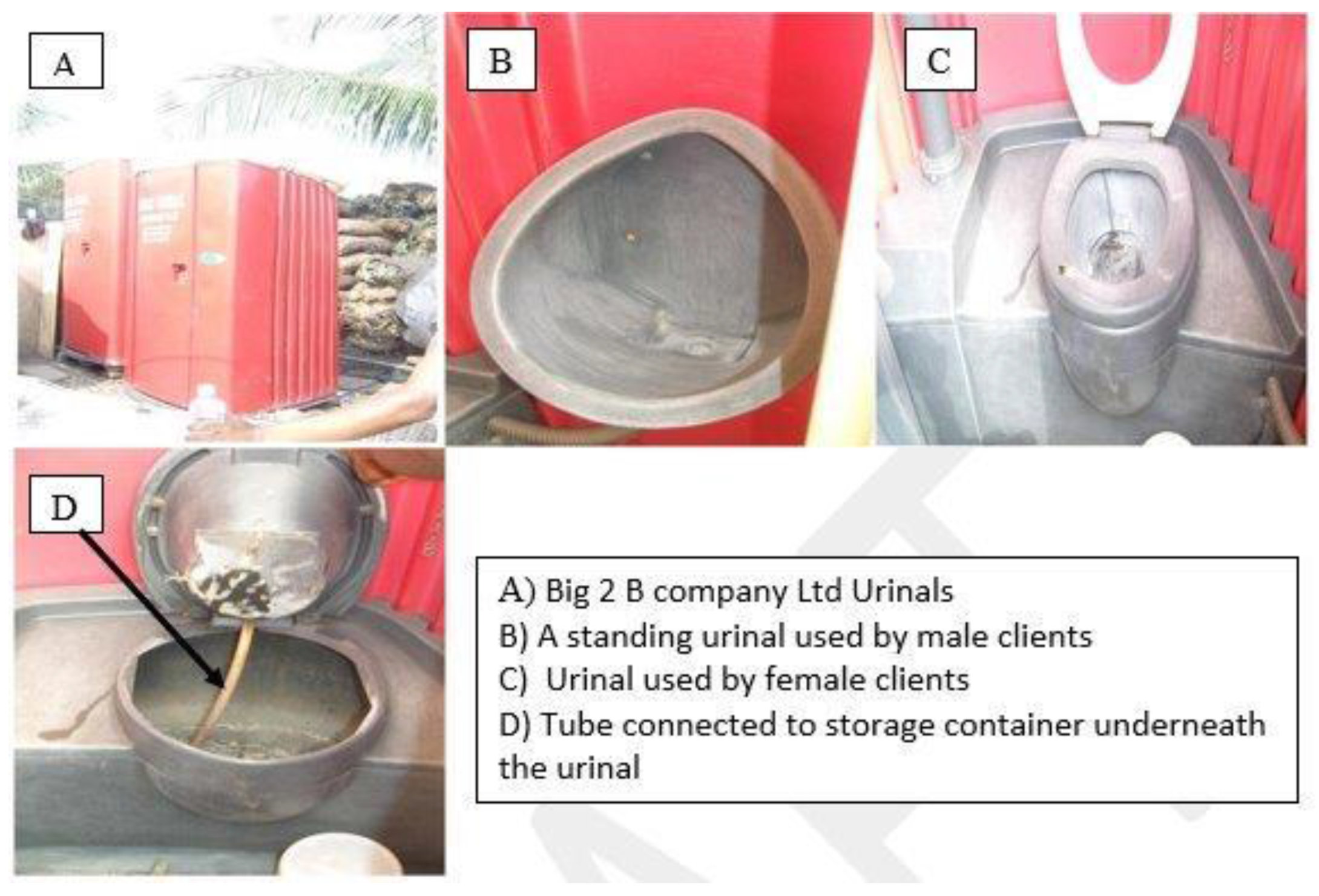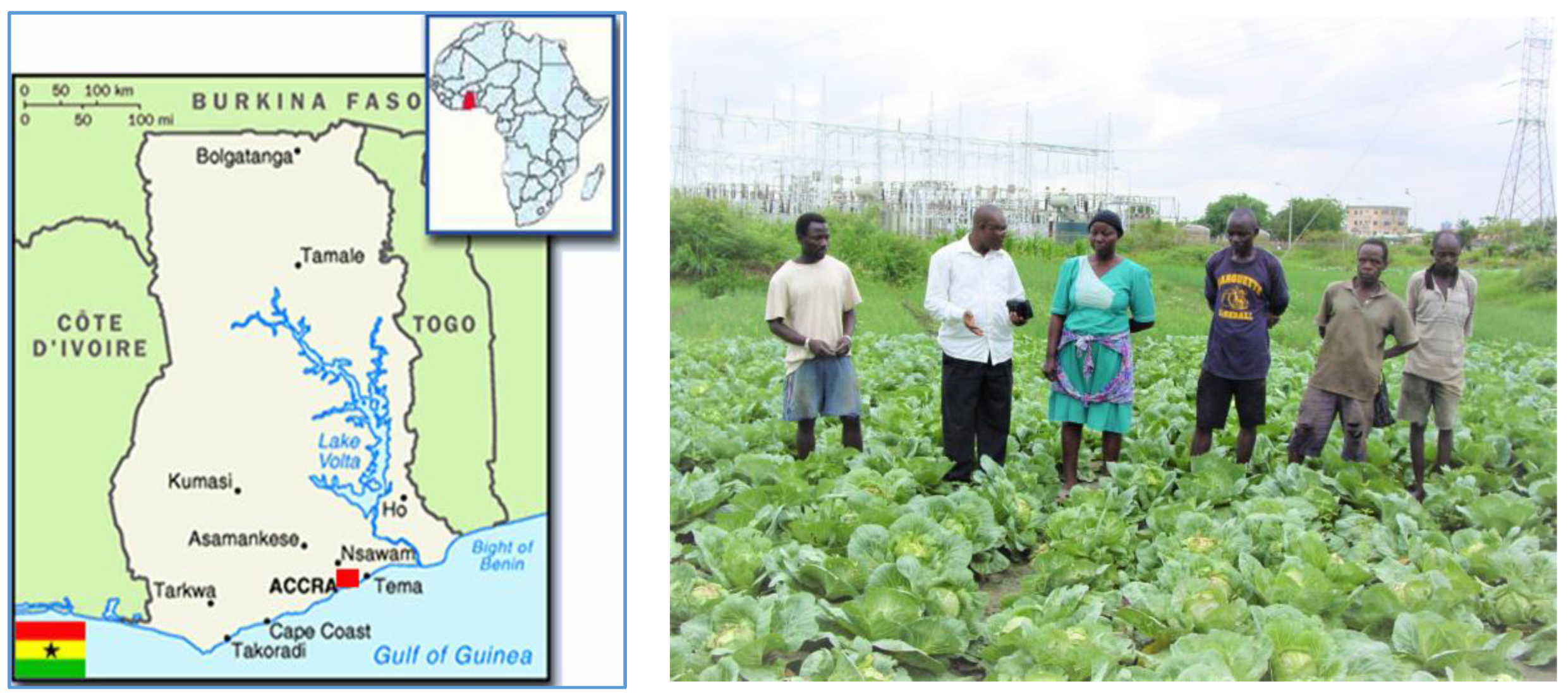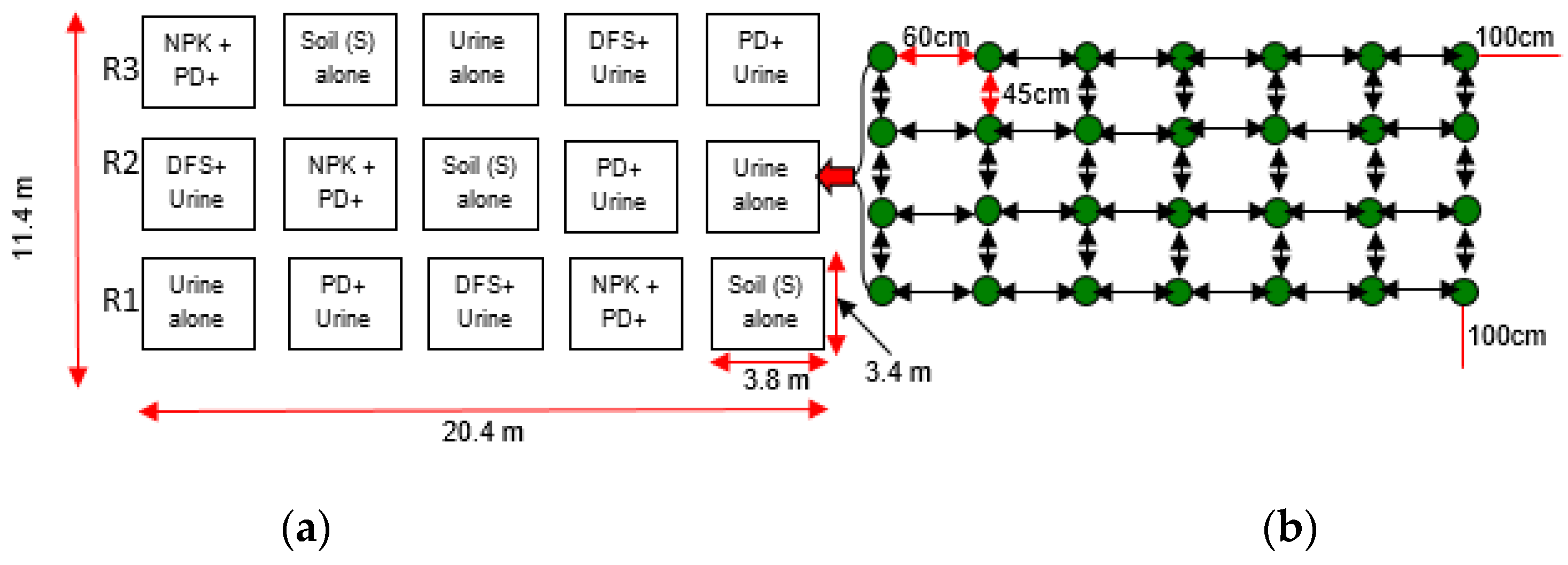1. Introduction
Globally, more people are living today in urban as opposed to rural areas. Over the span of nine decades since 1900, the global urban population increased rapidly from 2.4 million to 2.9 billion in 2000 and is expected to rise to 5 billion by 2030 [
1]. The rapid population increase is expected to take place mostly in urban areas of developing countries whose population is likely to rise from about 2 billion to 4 billion in 2030, averaging 2.4 percent per year [
1]. With the increasing population, absolute and relative growth in urban poverty and food insecurity are becoming a challenge for all people in urban areas.
Like most cities in developing countries, Ghana’s capital city Accra is experiencing rapid population growth and urbanization. The population of Accra has increased from about 300,000 in 1960 to about 2.3 million in 2016. This rapid urbanization has brought about urban poverty, food insecurity, and severe environmental degradation [
2]. To reduce the impact of food insecurity in urban areas, several cities, including those in developed countries, have given attention to urban agriculture, which is considered as part of the urban ecological system. Earlier studies in Accra observed that up to 90 percent of the city’s fresh vegetable consumption is from production within the city [
3,
4]. In the city, extensive urban agriculture takes place on seven main sites and there are about one thousand (1000) vegetable farmers as well as other farmers who are engaged in some seasonal crops such as maize and cassava. In addition to this, a considerable number of households are engaged in backyard gardening. As at 2004, it was estimated that about 17 hectares (ha) of land was under cultivation for maize, 20 ha under cultivation for pepper, 104 ha under cultivation for okra, and 14 ha under cultivation for tomatoes [
5,
6]. With the increasing use of agricultural land for residential and office buildings, the area under cultivation has reduced over the years. Farmers in some areas in Accra have lost 3 to 4 acres on average between 2009 and 2014 [
7]. As a result of this phenomenon, the intensification of agriculture, which requires the use of fertilizers to maintain soil fertility, will be required.
Farmers who practice commercial vegetable production in Accra normally use poultry manure and fertilizers for their business. However, the continuous use of fertilizer and its high cost is a constraint to farmers. Hence the possibility of using alternative sources like urine and dewatered faecal sludge should be explored to enhance the productivity of urban agriculture. Human urine contains essential nutrients needed for crop production and has therefore been suggested as an alternative source of fertilizer [
8,
9,
10]. It has been reported that the fertilizer value of pure urine is similar to NPK 18:2:5 [
11]. The use of urine as a source of fertilizer has been tested by some researchers in Finland, South Africa, Israel, and China [
12]. However, urine is not recycled yet in Ghana but released into the environment, which could lead to adverse environmental and health risks. For example, urine contains high concentrations of N and P which can cause eutrophication of receiving water bodies [
13]. Can urine and dewatered faecal sludge be used as an alternative source of fertilizer in Accra and other countries in the developing world? Maybe yes; however, studies on the feasibility of urine based farming systems are limited.
This study was therefore carried out to assess (a) the effect of urine and other organic inputs and fertilizers on cabbage growth, yield, nutrient uptake, N-use efficiency, and soil chemical characteristics; (b) the economic viability of the use of urine as a source of fertilizer for cabbage production.
4. Discussion
Generally, the urine, dewatered faecal sludge (DFS), and poultry droppings (PD) used in the trials contain appreciable levels of nutrients. This indicates that the organic inputs are essential sources for plant nutrients and a soil conditioner in agriculture. Human urine and or faeces as sources of plant nutrients have been studied and confirmed in countries like South Africa, Zimbabwe [
27], Ethiopia, Mozambique, Benin, Burkina Faso, Senegal, Cote d´Ivoire, Togo, Mali, Mexico [
28], China, Sweden [
29,
30,
31], and Germany [
32]. This study also confirms the high nutrient levels in human excreta.
The total nitrogen concentration (1.03% or 10.3 g·L
−1) was within the range (0.7–1.1% or 7–11 g·L
−1) reported in other studies for undiluted fresh human urine [
33,
34,
35]). The total nitrogen and phosphorus content of urine reduced after six months of storage, whereas the potassium content remained fairly the same. The reduction in the nitrogen content was due to volatilization exacerbated by a longer storage period (six months), whilst that of phosphorous was due to precipitation. According to Udert et al. [
36], about 95 to 100 percent of P in fresh urine is bound as dissolved phosphate. During storage, increased in urine pH trigged P to precipitate into struvite [MgNH
4PO
4·6H
2O] and hydroxyapatite [Ca
5(PO
4)
3(OH)] [
37,
38] which is finally deposited in the bottom of the storage tank. This may explain the low P content of urine under storage. To decrease the risk of loss of nitrogen during storage, the authors recommend urine to be stored in a sealed tank or container under a shed for a shorter time period (about a month). The precipitated P should also be removed and applied to the crops.
There were fairly high unmarketable yields from soils treated with NPK + PD and Urine + PD. This was as a result of rottenness. Pradan et al. [
33] reported that higher N uptake by cabbage might promote succulent plant parts which could make the crop susceptible to various forms of damage. In the current study, however, there was no significant correlation between plant N uptake and rottenness or unmarketable yields. There is therefore the need to conduct further research to ascertain the cause of the high level of rottenness.
The average cabbage weight per head (0.6 to 0.8 kg) obtained for all the treatments was fairly low compared to the values reported from several farms (1.1–1.2 kg) in Ghana [
39]. This was due to the poor performance of the crop in the rainy season as a result of heavy rainfall and flooding that occurred over the period of crop growth. This also explains the significantly lower head weight, and total and marketable yields in the rainy season compared to the dry season. The flood washed the soil and nutrients away and was also expected to affect the net photosynthetic rate [
40], and hence might explain the poor plant growth and low yields in the rainy season. Compared to yields reported from several farms in Ghana (30 to 40 tone ha
−1), the cabbage yields obtained from this study were very low. This may be attributed to varietal differences, poor crop performance due to the above-mentioned reason, and rottenness of cabbage head (the cost of which has not yet been ascertained). There was fairly high N, P, and K uptake from soils treated with Urine + PD; this can be attributed to the higher N and K content of urine and PD. This was expected to account for the increase in dry matter yield. Pradhan et al. [
33] similarly reported fairly high dry matter yields from Urine + PD treatments compared to NPK + PD treatments. There was significantly higher P uptake from Urine + PD and NPK + PD treated soil. This can also be attributed to the higher P content of poultry droppings and NPK. Masarirambi et al. [
41] also reported high levels of available phosphorus in poultry droppings, and high P uptake in soils treated with PD with a corresponding increase in crop yield. Similarly, the higher N recovery efficiency in Urine + PD compared to NPK + PD, Urine + DFS, or Urine alone can be attributed to the fairly high N uptake and dry matter yields especially in the dry season. The N use efficiencies for most of the organic inputs were within the range reported by Båth [
42]. He, however, reported that the N efficiency when using human urine alone could be high, ranging from 47 per cent to 66 per cent.
There was a significant interactive effect of treatment and season on soil NO3-N content, with fairly high concentration in soils treated with Urine + PD in the rainy season and NPK + PD in the dry season. The implication of the high soil NO3-N content is that the possible loss is through volatilization and leaching into the environment. This might consequently contribute to greenhouse gas (GHG) emissions and the pollution of water bodies. The fairly high increase in soil pH, N, P, and K under Urine + DFS, Urine + PD, and NPK + PD treatments gives an indication that with long-term cultivation the treatments have the potential to build soil fertility. However, the high soil NO3-N content, and the doubling of soil EC to a range close to 1.5 dSm−1 (salinity threshold values for the cultivation of most sensitive crops such as carrots, lettuce, etc.) is of great concern. The non-significant differences of the treatments’ effects on major soil characteristics can be attributed to the short period of cultivation and the past land use practices. There is therefore the need for the continuous monitoring of the use of urine and PD and the other treatments for a longer period.
The results of the financial analysis indicate that farmers could save substantial amounts of money (
$1452–1664) when they switch from using inorganic fertilizer and poultry droppings to urine and poultry droppings or dewatered faecal sludge for cabbage production. In addition, crops grown with urine provide a relatively longer shelf life than those from inorganic fertilizer treatment (Bonzi, et al. [
43]).








